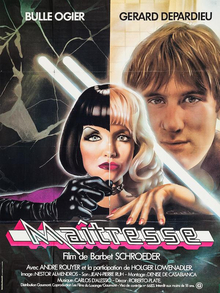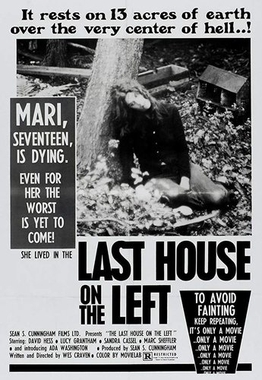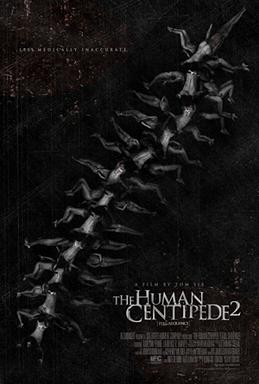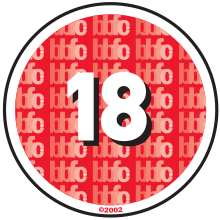A motion picture content rating system classifies films based on their suitability for audiences due to their treatment of issues such as sex, violence, or substance abuse, their use of profanity, or other matters typically deemed unsuitable for children or adolescents. Most countries have some form of rating system that issues determinations variously known as certifications, classifications, certificates, or ratings. Age recommendations, of either an advisory or restrictive capacity, are often applied in lieu of censorship; in some jurisdictions movie theaters may have a legal obligation to enforce restrictive ratings.
Video nasty is a colloquial term popularised by the National Viewers' and Listeners' Association (NVALA) in the United Kingdom to refer to a number of films, typically low-budget horror or exploitation films, distributed on video cassette that were criticised for their violent content by the press, social commentators, and various religious organisations in the early 1980s. These video releases were not brought before the British Board of Film Classification (BBFC) due to a loophole in film classification laws that allowed videos to bypass the review process. The resulting uncensored video releases led to public debate concerning the availability of these films to children due to the unregulated nature of the market.
This article chronicles the history of British film certificates.

Maîtresse is a 1975 French sex comedy film co-written and directed by Barbet Schroeder, starring Bulle Ogier and, in one of his earliest leading roles, Gérard Depardieu. The film provoked controversy in the United Kingdom and the United States due to its graphic depictions of BDSM.

The Last House on the Left is a 1972 horror film written and directed by Wes Craven in his directorial debut, and produced by Sean S. Cunningham. The film stars Sandra Peabody, Lucy Grantham, David Hess, Fred J. Lincoln, Jeramie Rain, and Marc Sheffler. Additionally, Martin Kove appears in a supporting role. The plot follows Mari Collingwood (Peabody), a teenager who is abducted, raped, and tortured by a family of violent fugitives led by Krug Stillo (Hess) on her seventeenth birthday. When her parents discover what happened to her, they seek vengeance against the family, who have taken shelter at their home.

Cannibal Holocaust is a 1980 Italian cannibal film directed by Ruggero Deodato and written by Gianfranco Clerici. It stars Robert Kerman as Harold Monroe, an anthropologist who leads a rescue team into the Amazon rainforest to locate a crew of filmmakers that have gone missing while filming a documentary on local cannibal tribes.

Baise-moi is a 2000 French erotic crime thriller film written and directed by Virginie Despentes and Coralie Trinh Thi and starring Karen Lancaume and Raffaëla Anderson. It is based on the novel by Despentes, first published in 1993. The film received intense media coverage because of its graphic mix of violence and explicit sex scenes. Consequently, it is sometimes considered an example of the "New French Extremity".

R18 is a film or video classification given by the British Board of Film Classification (BBFC). It is intended to provide a classification for works that do not breach UK law, but exceed what the BBFC considers acceptable in the 18 category. In practice, this means hardcore pornography.
The Maritime Film Classification Board is a government organization responsible for reviewing films and granting film ratings in New Brunswick, Nova Scotia and Prince Edward Island.

The Irish Film Classification Office (IFCO) is the organisation responsible for films, television programmes, and some video game classification and censorship within Ireland. Where restrictions are placed by the IFCO, they are legally binding.
The Lovers' Guide is a sex and relationships advice brand, produced by Lifetime Productions International Ltd, which launched with the release of the first Lovers' Guide video in the United Kingdom on 23 September 1991. Presented by the sexologist Dr Andrew Stanway, and produced by Robert Page and William Campbell, this became the only non-fiction film to top the UK video charts; it sold 1.3 million copies in the UK and went into 13 languages and 22 countries around the world.
In the United Kingdom, pornography is regulated by a variety of laws, regulations, judicial processes, and voluntary schemes. Pornographic material generally has to be assessed by regulators or courts to determine its legality. British censorship laws with regard to pornography have often been some of the most restrictive in Western Europe.
New Extreme Films describes a range of transgressive films made at the turn of the 21st century that sparked controversy, and provoked significant debate and discussion. They were notable for including graphic images of violence, especially sexual violence and rape, as well as explicit sexual imagery.

The British Board of Film Classification (BBFC), previously the British Board of Film Censors, is a non-governmental organisation founded by the British film industry in 1912 and responsible for the national classification and censorship of films exhibited at cinemas and video works released on physical media within the United Kingdom. It has a statutory requirement to classify all video works released on VHS, DVD, Blu-ray, and, to a lesser extent, some video games under the Video Recordings Act 1984. The BBFC was also the designated regulator for the UK age-verification scheme, which was abandoned before being implemented.
An obscenity is any utterance or act that strongly offends the prevalent morality of the time. It is derived from the Latin obscēnus, obscaenus, "boding ill; disgusting; indecent", of uncertain etymology. Generally, the term can be used to indicate strong moral repugnance and outrage in expressions such as "obscene profits" and "the obscenity of war". As a legal term, it usually refers to descriptions and depictions of people engaged in sexual and excretory activity.
Much of the regulation in the adult film industry has been limited to preventing child pornography. To enforce the age of entry restriction, most adult industry production companies are required to have a Custodian of Records that documents and holds records of the ages of all performers.
The Australian Classification Board is an Australian government statutory body responsible for the classification and censorship of films, video games and publications for exhibition, sale or hire in Australia. The ACB was established in 1970 and was once part of the Office of Film and Literature Classification (OFLC), which was dissolved in 2006. The Department of Communications and the Arts provided administrative support to the ACB from 2006 until 2020, when it was merged into the 'mega department' of the Department of Infrastructure, Transport, Regional Development and Communications. Decisions made by the ACB may be reviewed by the Australian Classification Review Board. The ACB now operates under the Commonwealth Classification Act 1995. The ACB is made up of a director, a deputy director, and three other board members, appointed by the government for three- or four-year terms, and temporary board members. The ACB is located in Sydney.
The Australian Classification Review Board is a statutory censorship and classification body overseen by the Australian Government. The corporate body is responsible for reviewing classification decisions made by the Australian Classification Board concerning films, video games and publications for exhibition, sale or hire in Australia. Review decisions need to be initiated by an appeal from a previous applicant, most commonly referred to as "aggrieved party", or a Federal or State Attorney-General.

The Human Centipede 2 (Full Sequence) is a 2011 psychological body horror film written, directed, and co-produced by Tom Six. An international co-production of the Netherlands and the United States, and the sequel to Six's 2009 film The Human Centipede (First Sequence), the film stars Laurence R. Harvey as a psychiatrically and intellectually impaired English man who watches and becomes obsessed with the first Human Centipede film, and decides to make his own "centipede" consisting of 12 people, including Ashlynn Yennie, an actress from the first film.

The Kenya Film Classification Board is a state corporation that operates under the Government of Kenya whose mandate is to "regulate the creation, broadcasting, possession, distribution and exhibition of films by rating them." The Board was founded in 1963 with the commencement of the laws outlined in the Films and Stage Plays Act of 1962 and has since involved itself in the rating and classification of films and television programmes. More recently, it has caused controversy by banning several films, such as the American box office success The Wolf of Wall Street, the Kenyan film Stories of Our Lives, Rafiki, and the 2015 film Fifty Shades of Grey based on the novel of the same name. The Board has also regulated television content, including advertisements.













